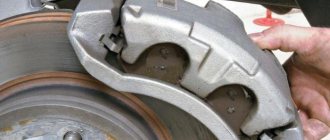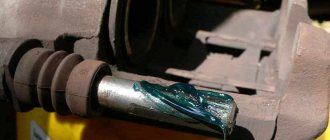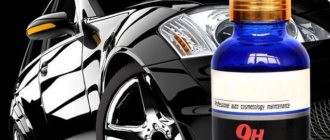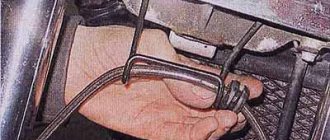When servicing calipers or replacing them, experts advise carrying out a procedure for lubricating the parts. This must be done because the caliper is one of the most important parts of the brake system. The safety of the driver and passengers depends on the correct operation of the braking system. Ignoring maintenance leads to blocking of the brakes and breakdown of various system elements. But many drivers do not know how to lubricate caliper guides correctly. Let's consider this issue in the presented material.
How to use it correctly
Before lubricating the caliper, the driver needs to understand the “instructions for use.” Let us list the main secrets of using the substance:
Anti-squeak plates need to be treated with the substance, provided that extraneous squeaks occur during braking.
Any parts that have been replaced or serviced are lubricated with the appropriate composition.
The driver should clean the area of the pressure pads himself from time to time.
As soon as problems appear with the movement of the piston, it is treated with a lubricant. This must be done correctly, without excesses, otherwise everything unnecessary will “jump out” of the anthers.
When working, the main thing is not to overdo it. Excess will fall on the work surface, which is not desirable, since the substances are not intended for this.
Lubrication requirements
Even if the car owner knows how to lubricate the caliper guides, he needs, first of all, to select the correct composition. They are subject to special requirements based on the operating conditions of the braking system (TS).
The product must have:
Heat resistance - the elements of the mechanism become very hot (up to +180°C).
Frost resistance - exposure to -15-20°C or more.
No destructive effect on rubber and plastic.
Highly resistant to various automotive fluids and moisture.
Pastes should have a viscous consistency and not wash off at the slightest impact.
All of the above requirements are the most basic. You can also provide additional ones. For example, corrosion protection is an important property that is not found in all lubricants. Experts claim that products from the Litol and Nigrol brands are not suitable for processing elements, since they are not able to “withstand” aggressive working conditions. As a result, piston seizure and brake failure may occur.
Types of lubricants
Lubricants are sold in different formats: as a paste or spray. Which composition to choose? It depends on how the driver operates the car. If we take sports cars as an example, then when driving their calipers heat up to +300°C. Also, do not forget that those who drive a car in winter expose parts to moisture and road reagents.
Drivers who do not understand trains buy budget options. These include the familiar nigrol or lithol. Unfortunately, these products do not meet the quality characteristics. They perform the task assigned to them, but ineffectively. It is best to buy a composition from a well-known brand.
Today, the following varieties are presented on the auto lubricants market:
Mineral (synthetic) pastes containing metals. This species can withstand severe frost and excessive heat. Its operating temperature range is -180°C to +1100°C. The metal component may be in the form of copper powder, magnesium silicate, or a combination of aluminum, graphite and copper.
Classic mineral pastes include fatty acids in combination with metal and bentonite. Withstands from -45°C to +185°C. These characteristics are enough for the brake unit to work smoothly. The lubricant retains its consistency. The paste is used to lubricate bolts, rods, cylinders, etc.
Classic synthetic oils - the main component of the composition is silicone. To make the substance “work” better, additives are added to it. With their help, the components are reliably protected from the aggressive influence of liquids and acids. Operating temperature varies from -40°C to +300°C. The paste has a semi-liquid consistency that can be used to lubricate guides and other elements.
But another important characteristic of the lubricant is the manufacturer. High-quality products are produced by companies specializing specifically in lubricants. Today the Toyota and Slipkote brands have proven themselves well.
Compositions for treating caliper elements
The scope of application of materials of the second group is static parts of brake mechanisms. This includes bolts of threaded connections, rubber and plastic covers, rods and various bushings. They are made on mineral bases and are not subject to melting (English designation - Rubber Grease). The temperature range in which the lubricant works without problems is from minus 40 to +180 ° C.
Important point! Lubricants of this group are not intended for application to moving parts - guides and cylinders. It is allowed to process the end part of the piston pressing on the block.
The products on the market are represented by the following brands;
- ATE Plastilube (Germany);
- composition Loctite Teroson Plastilube with a thickener based on natural clay;
- Teroson Plastilube from the famous German manufacturer Continental Teves, specializing in brake units.
Application of the listed lubricants creates the effect of surface preservation. Simply put, a few years after processing, the threaded connections unwind and the assembly is easily disassembled. Conventional silicone grease is not suitable for car calipers - the operating temperature is too high.
We recommend: How to remove and clean injectors on a VAZ 2110 with your own hands: washing and chemicals
Recommended Brands
When a car owner is faced with the question of what to lubricate the caliper guides with, many problems arise regarding the choice. The products of the following companies are very popular:
Liqui Moly is a well-known brand that offers a wide range of pastes. Among the manufactured products you can find universal products for calipers and pistons. Pastes cannot be considered budget, but many drivers are delighted with the quality.
TRW is a manufacturer that is very popular among Russian drivers. The products are sold in different versions, but the owners recommend buying 25 g tubes.
PAG is a domestic analogue of TRW products. Lubricants contain calcium and lithium. Sold in 5 gram tubes.
Similar products are not made by many popular brands that produce oils.
TOP 5 best lubricants
Among the wide variety of products, there are always those that are most in demand. The current review has collected the five best products in terms of price and quality ratio.
Lavr BRAKE CONTROL is a semi-synthetic paste with frost resistance. It can also withstand high temperatures up to + 1000°C. The average cost is 115 rubles. The main feature of the substance is its versatility. Lubricant can be applied to guides and calipers, as well as to piston cylinders. The only drawback of the product is that there are often manufacturing defects.
ABRO Synthetic Brake & Caliper Grease is a budget lubricant containing molybdenum and Teflon. ABRO is considered a well-known manufacturer producing high-quality products. It is this composition that has the best characteristics. The synthetic substance perfectly protects the brakes from wear.
TRW PFG110 is a high-quality lubricant that interacts well with different surfaces. The composition contains a large set of additives with water-repellent properties. The substance is also resistant to reagents. Before the treatment procedure, the brake system must be degreased. After application, the substance creates a film on the surface of the elements that protects against rust formation. The product is manufactured in America, and therefore has a high cost compared to analogues.
VMPAUTO MS 1600 is a lubricant for calipers that can withstand up to +1000°C. This high temperature substance has anti-corrosion properties. The brand not only produces products under its own brand, but also tests them in the laboratory. Thanks to constant testing, the manufacturer was able to increase the temperature threshold. The advantages of the lubricant include plasticity and affordable price.
RUSEFF is a product that is often included in various reviews and car ratings. This is a Russian brand of synthetic-based lubricants. The composition contains anti-friction components. However, do not apply the composition to the piston cylinder or moving fingers. The advantages of the product include a low freezing threshold and recommendations from experts.
Classification of types of lubricants
The question of what is the best way to lubricate the caliper guides is relevant only for beginners, but also for experienced drivers. On the modern market there is a huge range of lubricants that differ in composition, specific criteria, price and manufacturer. Responsible drivers realize that the “braking system” does not imply savings, since lives, and more than one, may depend on it, and therefore they wonder how to choose the right lubricant. To choose a good lubricant for brake calipers, you first need to study in detail the types of products available for sale, taking into account their technical characteristics, and only then give preference to one of the product categories.
We recommend: Auto parts and accessories for cars: where and why it is profitable to order
When selecting a lubricant, the following criteria should be taken into account:
- resistance to water and aggressive chemical components; maintaining high temperature conditions with a starting point of one hundred and eighty degrees and above;
- stability of technical characteristics at extreme sub-zero temperatures, which is important in winter;
- the absence of components that can have a destructive effect on rubber and plastic components and seals.
The entire range of lubricating products is conditionally divided into three categories: emulsions of the synthetic or mineral series with the inclusion of metal-containing components in the structure, products based on mineral oils and synthetic substances. Let's look at the top products in this segment.
Xado VeryLube
How not to buy a fake?
Before purchasing a lubricant, you must visually inspect the product packaging. On fakes, as a rule, not all inscriptions and signs of the brand are applied. Also, the tube is made of low-quality material, which is noticeable even to the touch.
Counterfeits are found “at every step” today. Trying to save money, drivers buy them without receiving a positive effect in return. In addition, low-grade pastes can render calipers, guides and discs unusable. Ultimately, the owner has to pay a lot of money to repair the brake system.
What shouldn't be lubricated?
Many drivers do not know how to lubricate brake calipers, since the range of lubricants is quite wide. The previous paragraph discussed products that can be used for processing. In order not to get confused in the choice, you also need to know what substances should not be used to lubricate the caliper guides.
It is prohibited to use ceramic and copper pastes for lubrication. They can only process the pad inserts into the caliper.
It is not recommended to use copper and graphite compounds. Otherwise, the lubricant will dry out and the finger will jam.
Lithol is never used for finger strokes, since the substance becomes liquid when heated strongly. It spreads and corrodes the anther.
All of the above prohibitions must be taken into account if there is a need to lubricate the caliper. There is no need to rely on the advice of strangers. An incorrect lubrication process can lead to irreparable consequences.
Lubricant for calipers and guides
To facilitate the operation of the brake mechanism elements as they operate in poor circumstances, lubricant is used for the caliper and guides. There are few varieties of lubricants. We will systematize the data and answer several questions that interest car owners.
Types of lubricants
Specifically, we will examine the following topics:
- Existing types of lubricants
- Copper Grease (High Temperature)
- List of lubricants for caliper and guiding elements
- What type of caliper lubricant is best?
- Feedback on famous lubricants
Types of lubricants
Let us immediately point out that companies divide the lubricant into two types - paste and spray. Before moving on to listing their types and brands, you need to determine what properties the caliper lubricant should have. If you have an aggressive driving style or drive in the mountains, the degrees in the calipers reach up to plus 300, and in the city it warms up to plus 150-200 degrees. In addition, the caliper is affected by humidity, dirt, and chemical compounds sprinkled on the roads. Therefore, the lubricant for the caliper and its directional elements must have the following properties:
- Do not be aggressive towards car parts made of plastic and rubber.
- So that it does not lose its properties under the influence of water, brake fluid or other solutions that can wash it off or dissolve it.
- Withstand high temperatures, do not lose their degree characteristics at plus 180 or more.
- It is not obliged to lose its physical properties in extreme cold (from minus 35 and below).
Inexpensive lubricants that are used everywhere will not provide the above conditions. We are talking about graphite paste, lithol, nigrol and others similar to them. Otherwise, for good performance of the brake system, specifically the caliper, modern developments must be used.
Nowadays, manufacturers produce the following groups of lubricants for calipers:
Group 1 - mineral pastes , using metals in them. They are classified as high-degree extreme pressure. Their active range is large, from approximately minus 185 to plus 1100 degrees (each lubricant has its own active range).
The substance is based on synthetic and mineral oils; thickeners are added to their composition, as well as small metal parts (copper or molybdenum). These include the following subtypes:
- Complex pastes containing copper, aluminum and graphite powder.
- With copper, which contain copper and graphite powder.
- Pastes without metal particles are replaced with magnesium silicate and ceramics.
- Lubricants based on copper or molybdenum disulfide.
Below is a list of certain brands of lubricants of this type:
- pastes in the complex - Husky 2000 Lubricate Paste and Anti-Saitz Compound for High Temperatures, Loctite No. 8060/8150/8151, Wurth AL 1100;
- pastes with copper - Husky 341 Copper Anti-Seize, Likyu Moli Kupfer-Paste, Mannol Kupfer-Paste Super-Hafteffekt, Marley Cooper Compound, Molikot Cu-7439 Plus Paste, Motip Koperspray, Permatex Copper Anti-Seize Lubricant, Pingo Kupfer-Paste , Valvoline Cooper Spray, Wurth SU 800;
- pastes with no metal particles - Husky 400 Anti-Seize, TEXTAR Cera Tec, Lykyu Moli Bremsen-Anti-Quietsch-Paste;
- pastes with molybdenum disulfide - HUSKEY Moly Paste, Assembly Lubricant & Anti-Seize Compound, Loctite No. 8012/8154/8155.
Pastes that belong to this group are needed for the direction fingers of brake calipers and all sorts of heavily loaded rubbing upper layers, except for the active upper layers of brake pads!
2nd group - Pastes with mineral oil. They contain bentonite, which acts as a thickening agent. In addition, metal particles and fatty acids are also added here. The main advantage of samzka on the mineral is its stable activity in the degree range from minus 45 to plus 180. The paste will not flow out and will not lose its characteristics. So, it is perfect for lubricating the directional calipers of a car that is operated in light conditions. An example of such a lubricant of this type is Teroson VR500.
3rd group - lubricants with synthetic oil. These are lubricants with universal properties, as they are suitable for lubricating the caliper, but also other parts of the car’s brake system. Lubricants are made from pure synthetic oil, and also additives that have anti-corrosion, anti-oxidation, and anti-wear properties. It also contains a thickener. Synthetic oil-based lubricants with excellent properties. They are not dissolved in water, brake fluid, acidic or alkaline media, they are not evaporated, and they also have dielectric properties. The range of operating temperatures is approximately from minus 40 to plus 300 degrees.
Examples of lubricants are Molikot AS-880N Grease, Permatex Ultra Disk Brake Caliper Lube, SLIPKOT 220-R Silicone Disc Brake Caliper Grease and Noise Suppressor, SLIPKOT 927 Disc Brake Caliper Grease.
The scope of their application is wide. They can be used for lubricating slippery and swing bearings, and other elements that operate under conditions of high temperature and high pressure.
The most popular types of pastes and sprays for parts - calipers and guides - are copper-based lubricants, which are a type of lubricant that uses metal. Let's talk about them briefly.
Grease with copper (high degree)
It, like other caliper lubricants, is classified as high-grade. Otherwise, it can withstand significant degree overloads when the brake system operates.
Lubricants with copper come from three main components - fine, finely dispersed copper, oil (mineral and synthetic), and a few other substances designed to resist rust. Lubricants are sold as pastes or sprays. They have a high viscosity, so they penetrate into the gaps without flowing back out.
The advantages of lubricants with copper are that they have a wide operating temperature range, reduced rubbing force, and no evaporation or dew points. If you decide to use a lubricant with copper, you must comply with the conditions for its lubrication. This element's working surface must be very well cleaned. It is necessary to apply the lubricant carefully so that dirt does not get on the part with it, and you should not remove excess lubricant.
If the caliper of your car is made of aluminum, then you cannot use lubricant with copper because contact rust of the aluminum will occur (because the two metals cannot be “friends” with each other).
Let's consider lubricants for the caliper and guides
Molykote Cu-7439 Plus
Molykote Cu -7439 plus . Made in America based on fine copper powder and semi-synthetic oil. This is the most famous and in demand caliper lubricant today, as its advantages include:
- degree active range - from minus 30 to plus 600;
- pressure resistant;
- evaporates little;
- there is no washability or solubility.
In addition, this lubricant is not only high-temperature, but will also perfectly protect brake system parts from rust, oxidation and sticking. It is recommended to use such world leading companies as Land Rover, Nissan, Honda, Subaru.
Lubricant for MC-1600 calipers, comparable to similar ones.
Consider lubricants Molikot Cu-7439 Plus
MS-1600
MS-1600 made in Russia. From our products, we will single out a lubricant that is well-known today and has the universal properties of high-temperature pastes. Its active range is 50 - 1000 degrees. Like similar ones, the lubricant is resistant to the action of all reagents, acids, alkalis, and water. In addition, it does not adversely affect the rubber and plastic parts of the car brake system; it has anti-corrosion and non-stick properties. According to the company's instructions, this white paste is suitable for lubricating non-working and end block surfaces, guiding parts and processing the caliper piston.
MS-1600 does not interact with brake fluids of classes DOT 3, DOT 4, DOT 5.1. One 100 gram tube of MC1600 costs about 6-8 dollars, but it is convenient, you can buy only a five gram tube, it will be enough to replace one set of pads, for only sixty to eighty rubles.
It is worth noting that MS-1600 should not be used together with a liquid brake solution of DOT 5.0 class.
XADO VeryLube
XADO VeryLube . An economical type of caliper lubricant. It is needed to prevent jamming and jamming of brake pads on the caliper guide parts. Sprays are available for sale (green in color), in a cylinder, volume 320 ml. active degrees - from 35 to plus 400 degrees. Behaves neutrally towards rubber materials. When working, you need to apply five layers of lubricant, allowing each to dry. Perfect for those who don't want to pay a lot and buy a high quality product, although the cost is a little higher. One beam costs three to four dollars. The license plate number when ordering Xado multi-purpose lithium lubricant is XB40019.
SLIPKOT 220-R DBC
SLIPKOT 220- R DBC is also an excellent lubricant for calipers, and, importantly, it has many approvals for use in drinking water supply mechanisms. According to the responses of many drivers, this is one of the best means for lubricating directional elements. But for many, difficulties arise during acquisition. A good solution is to order from another country. The degree dative range is from minus 46 to plus 299 degrees. It is made on the basis of pure synthetic oil, a thickener and additives that give it anti-rust, anti-oxidation and anti-wear characteristics.
The company supplies lubricants under the SLIPKOT brand to automobile manufacturing plants. In stores, the product is sold by Penzoil, Lostit, PERmatex, TRV Autospeciality, Toyota. In the ordering catalog it is written as Husky 72983, or if for Toyota, then 0888780609. While there are advantages, the lubricant has a drawback - it is expensive. One package weighing 85 g. Costs about 20 dollars.
Worth adding! On vehicles with drum brakes, the use of Slipcoat 220-R DBC is prohibited. Here you can use, for example, Husky 2000 Anti-Size.
LIQUI Moli Bremsen-Anti-Quietsch-Paste
LIQUI MOLY Bremsen-Anti-Quietsch-Paste , we do not recommend you buy this lubricant. Not taking into account the degree properties that the manufacturer gives, from minus 40 to plus 1200 degrees, it has many disadvantages. At first it actually served as a lubricant for the caliper direction elements. But after a little time, drivers began to have problematic issues due to his work. And the company downgraded its status to anti-creak. Even on their website there is information that “it is not recommended to lubricate the guide elements of calipers with it and put it in the anthers.” But today, most online stores and bad sellers, without knowing it, either specifically sell it as a lubricant for calipers. But this does not mean that Liqui Moly does not have a good lubricant for the caliper; other brands have shown themselves to be very good.
Best caliper lubricant
When talking about the results of which lubricant is better for a caliper, you need to take into account the following points: the operating characteristics of the car, the wear rate of the brake mechanism, the car model, the cost of the lubricant.
If you have an ordinary car and you drive quietly, then you don’t need to pay a lot and buy an expensive lubricant. For example, you can purchase the currently well-known domestic lubricant MS-1600 or the lubricant for the Hadot Very Lube caliper.
Degree test of caliper lubricants
If you have an expensive car and you perform sharp maneuvers with heavy loads (races, mountains), then you need to purchase an expensive lubricant. For example, Slipkot 220-R DBC or Molikot Cu-7439 Plus. They operate over a wide degree range and provide excellent protection for the caliper and brake mechanism. Therefore, cost often remains the main condition when purchasing. It will be good if the responses given below about a few brands of lubricants help you with your purchase.
Caliper lubricant reviews
Having collected recommendations and experience of drivers using famous lubricants, we have provided responses that will help you compare the pros and cons of each of them.
Slipcoat 220-R DBC
| Positive | Negative |
| To lubricate the cylinder and on the guides, I use Slipcot 220R... I recommend this to everyone I know. | Didn't notice |
| More than a month has passed since lubricating the calipers on a Toyota Camry with Slipcot 220R DBC lubricant, and there are still no squeaks, crackles or clicks. | |
| Brembo wheels; Nishimbo pads - lubricant for Slipkot guides 220 RUR, and on the plates, lubricated with Liqui Moly paste with copper. Everything is fine, I drove 12-20,000 km. It’s easy to find lubricant in the capital |
Molikot Cu-7439 plus
| Positive | Negative |
| Regarding Molikot Cu-7439 Plus, it is really a suitable lubricant for directional elements | Mollicot Cu-7439 Plus is not suitable for directional elements. This is a simple paste the same as Liqui Moly Bremsen-Anti-Quietsch-Paste, Permatex Copper Anti-Seize Lubricant, Husky 2000, Wurth CU-800, Phoebe 31942. |
| I have already met with the products of the manufacturer Molikot, before I bought CU-7439 Plus for directional elements. The guides began to move perfectly, there was no rust. | |
| I've been lubricating it for over a year. Excellent lubrication. There is no rust and the elements do not oxidize. | |
| On my Ford, I use Molikot Cu-7439 plus to lubricate the caliper - the cost and quality are good, without smudges. |
Hado Very Lube
| Positive | Negative |
| A good product. The only thing I don’t like is that you have to lubricate a couple of layers on the calipers. | I do not like. After use, after a certain period of time it became thick, and after a few months it became coked, and the motor activity of the calipers became less. |
| For directional elements and caliper cylinders under the boot, an excellent choice. You just need to smear the layers with a rest of two to three minutes. | Lubricant "G", the money wasted |
| If I’m not mistaken, I’ve been using XADO for 150,000 km already. There are no problematic issues yet. | Not suitable for directional elements |
| Someone said that VeriLub was “shit,” but I was satisfied. I started using it for 10,000 km, now it’s 60,000, everything is fine. The VeriLub can lasts for three seasons (6 shifts) and I still have a lot in it. (Logan car) |
MS1600
| Positive | Negative |
| Good feeling from the lubricant. I like that the squeaking instantly disappeared. | What the manufacturer stated raised doubts; there are no international approvals. |
| I tried it, it’s inexpensive and the quality is good. After replacing the pads again and using this lubricant, the linings now began to wear down equally | The substance is thick. I smeared the guides. During the winter period, the pads wore out unevenly - the inside wore off more than the outside. The lubricant dried out within 12 months and became like grayish plasticine. The bottom of the piston boot is completely dry. I don’t recommend applying it as an anti-squeak, I often found in the responses that the squeaks soon returned. It’s good when you have a few good special lubricants that have been tested for a specific unit rather than one universal one. |
Frequency and correctness of the procedure
How to lubricate calipers correctly? This question worries everyone who is going to replace and service parts. First you need to understand which element requires processing. These could be anti-squeak plates, pad pressure springs, etc.
To carry out the procedure, you will need a tube of the substance. The paste is orange in color. By the way, it is also often included in repair kits. If you cannot find a substance with a thick consistency, you can purchase high-temperature paste in bags.
First you need to remove the caliper guides and clean them of dust. It is advisable to change the anthers at the same time. But if this is not possible, then it is also better to remove them, wash and dry them. Lubricant is applied to the finger and under the anthers. The main thing is that the layer is not too thick. It won't do any good. If there are defects on any parts, you need to eliminate them or replace the parts with new ones.
Brake caliper lubrication materials
As we have already seen, caliper lubricants are a very narrow group of lubricants, but it can and should be divided into several subgroups.
- Extreme pressure lubricants with high temperature resistance. They are used on brackets, as well as for lubricating the metal surfaces of pads and anti-squeak plates. The composition of these lubricants may include powders of copper, aluminum, graphite, with molybdenum disulfate fillers, as well as with synthetic or inorganic fillers.
- Edge compounds for bolts, guide pins, seals and polymer-containing elements. On the manufacturer's packaging it is designated as Rubber Grease. It is important to note that standard silicone compounds are not used for these purposes.
- Universal lubricants for all caliper elements, including parts containing polymers and rubbers.






